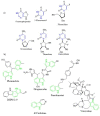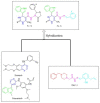Design, Synthesis, Molecular Modeling and Antitumor Evaluation of Novel Indolyl-Pyrimidine Derivatives with EGFR Inhibitory Activity
- PMID: 33805918
- PMCID: PMC8037142
- DOI: 10.3390/molecules26071838
Design, Synthesis, Molecular Modeling and Antitumor Evaluation of Novel Indolyl-Pyrimidine Derivatives with EGFR Inhibitory Activity
Abstract
Scaffolds hybridization is a well-known drug design strategy for antitumor agents. Herein, series of novel indolyl-pyrimidine hybrids were synthesized and evaluated in vitro and in vivo for their antitumor activity. The in vitro antiproliferative activity of all compounds was obtained against MCF-7, HepG2, and HCT-116 cancer cell lines, as well as against WI38 normal cells using the resazurin assay. Compounds 1-4 showed broad spectrum cytotoxic activity against all these cancer cell lines compared to normal cells. Compound 4g showed potent antiproliferative activity against these cell lines (IC50 = 5.1, 5.02, and 6.6 μM, respectively) comparable to the standard treatment (5-FU and erlotinib). In addition, the most promising group of compounds was further evaluated for their in vivo antitumor efficacy against EAC tumor bearing mice. Notably, compound 4g showed the most potent in vivo antitumor activity. The most active compounds were evaluated for their EGFR inhibitory (range 53-79%) activity. Compound 4g was found to be the most active compound against EGFR (IC50 = 0.25 µM) showing equipotency as the reference treatment (erlotinib). Molecular modeling study was performed on compound 4g revealed a proper binding of this compound inside the EGFR active site comparable to erlotinib. The data suggest that compound 4g could be used as a potential anticancer agent.
Keywords: EGFR; cancer; drug design; indole; molecular modeling; pyrimidine.
Conflict of interest statement
The authors declare no conflict of interest.
Figures








Similar articles
-
Design, synthesis and anticancer evaluation of thieno[2,3-d]pyrimidine derivatives as dual EGFR/HER2 inhibitors and apoptosis inducers.Bioorg Chem. 2019 Jul;88:102944. doi: 10.1016/j.bioorg.2019.102944. Epub 2019 Apr 25. Bioorg Chem. 2019. PMID: 31051400
-
Pyrazolo[3,4-d]pyrimidine-based dual EGFR T790M/HER2 inhibitors: Design, synthesis, structure-activity relationship and biological activity as potential antitumor and anticonvulsant agents.Eur J Med Chem. 2021 Mar 15;214:113222. doi: 10.1016/j.ejmech.2021.113222. Epub 2021 Jan 26. Eur J Med Chem. 2021. PMID: 33545637
-
Synthesis of Novel Thieno[2,3-d]pyrimidine Derivatives and Evaluation of Their Cytotoxicity and EGFR Inhibitory Activity.Anticancer Agents Med Chem. 2018;18(5):747-756. doi: 10.2174/1871520618666180124121441. Anticancer Agents Med Chem. 2018. PMID: 29366427
-
2-Anilinopyrimidine derivatives: Design, synthesis, in vitro anti-proliferative activity, EGFR and ARO inhibitory activity, cell cycle analysis and molecular docking study.Bioorg Chem. 2020 Jun;99:103798. doi: 10.1016/j.bioorg.2020.103798. Epub 2020 Mar 29. Bioorg Chem. 2020. PMID: 32247112 Review.
-
Pyrimidine-based EGFR TK inhibitors in targeted cancer therapy.Eur J Med Chem. 2021 Oct 5;221:113523. doi: 10.1016/j.ejmech.2021.113523. Epub 2021 May 4. Eur J Med Chem. 2021. PMID: 33992931 Review.
Cited by
-
Anticancer potential and structure activity studies of purine and pyrimidine derivatives: an updated review.Mol Divers. 2025 Feb;29(1):817-848. doi: 10.1007/s11030-024-10870-4. Epub 2024 Jun 10. Mol Divers. 2025. PMID: 38856835 Review.
-
Identification of bicyclic compounds that act as dual inhibitors of Bcl-2 and Mcl-1.Mol Divers. 2023 Jun;27(3):1359-1374. doi: 10.1007/s11030-022-10494-6. Epub 2022 Jul 31. Mol Divers. 2023. PMID: 35909144
-
Discovery of new symmetrical and asymmetrical nitrile-containing 1,4-dihydropyridine derivatives as dual kinases and P-glycoprotein inhibitors: synthesis, in vitro assays, and in silico studies.J Enzyme Inhib Med Chem. 2022 Dec;37(1):2489-2511. doi: 10.1080/14756366.2022.2120478. J Enzyme Inhib Med Chem. 2022. PMID: 36093880 Free PMC article.
-
Eco-friendly and regiospecific intramolecular cyclization reactions of cyano and carbonyl groups in N,N-disubstituted cyanamide.Mol Divers. 2022 Oct;26(5):2813-2823. doi: 10.1007/s11030-022-10401-z. Epub 2022 Feb 27. Mol Divers. 2022. PMID: 35220547
-
Design, Synthesis and Anticancer Activity of a New Series of N-aryl-N'-[4-(pyridin-2-ylmethoxy)benzyl]urea Derivatives.Molecules. 2021 Jun 8;26(12):3496. doi: 10.3390/molecules26123496. Molecules. 2021. PMID: 34201326 Free PMC article.
References
MeSH terms
Substances
LinkOut - more resources
Full Text Sources
Other Literature Sources
Medical
Research Materials
Miscellaneous

